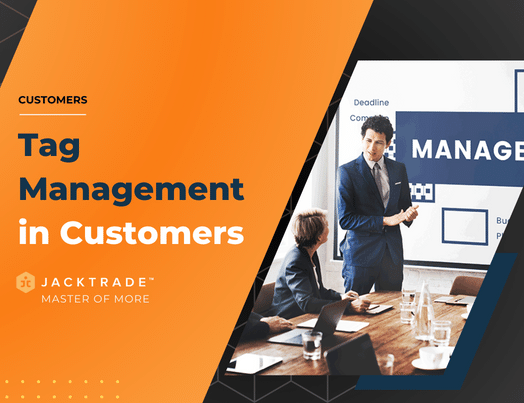Tagging System
Tagging is a powerful tool for distinguishing, grouping, or categorizing your data as you want for your sales, marketing, or operations. Tags are also known by other names, such as categories, contact types, classifications, groups, and buckets. Jacktrade supports tagging almost everywhere on the platform so you can freely design your data around specific interests, activities, or workflows.
A tag is a keyword or label assigned to a piece of information (such as a database record, digital image, or file). This kind of metadata helps describe an item and allows it to be found again by browsing or searching.
Tags are generally chosen informally and personally by the item’s creator or by its viewer, depending on the system, although we recommend that your tags should be chosen from a controlled library.
An analogous example of tags in the physical world is museum object tagging. People were using textual keywords to classify information and objects long before computers. Today digital platforms like Jacktrade provide search algorithms that make the use of such keywords a rapid way of exploring records.
Benefits of Tagging
The primary use of tags is to organize your data in such a way that it meets the needs of your business. People use tags to aid classification, mark ownership, note boundaries, and indicate online identity. Tags may take the form of words, images, or other identifying marks. Tag management helps marketers and sales tame the “beast” that lurks within their digital operations. With each small business being unique, there’s no “absolutely right” formula for your business tags.
Besides, tagging is more than just client-facing communication. You can also use tags to organize work for both yourself and your team, offering important insights into how to talk with your clients at any given time without having to ask questions.
Tagging Example Use-Cases
Let's get you acquainted with the way you can optimally use the tagging system. There are abundant cases where tagging becomes an integral part of your customer profile. Here are smart, general tags small businesses should consider rolling out with the help of Jacktrade.
-
- New Lead – (tag: “new lead”) - A new lead requires you and your team to pay special attention in terms of response time, nurturing, and following up. Naturally, this is a tag you can remove when the prospect turns into a customer.
- Type of Service (tag: “filter change”) - Your ability to offer complimentary or additional services is based on the services you know clients have already purchased. Think of Amazon’s “Customers who bought this item also bought…”
- Special Days (tag: “birthday – march”, “anniversary – April”, etc) - Perfect for putting a smile on your clients’ faces, happy birthday greetings and coupons are just another way to make a positive impression on your loyal base.
- Customer Persona or Connection Type - A user (or buyer) persona is a fictional representation of a business's ideal customer. Tagging your contacts with your target personas would be immensely helpful to your sales and marketing process. Examples: Nurse, Doctor, Technology Executive, Operations Manager, etc
- Tag your records based on the relationships they have with your business. For example, a record can be an influencer, prospect, lead, vendor, or partner. Categorize those records using multiple tags and sort or filter them whenever required.
- By Business Type - A broader approach could be to use tags based on the type of business your customers are affiliated with. Perhaps you’re a marketing company, or you offer a service that is used by a wide variety of different companies. If so, this approach makes sense for you, as it will allow you to determine which prospects are tied to a small business, an agency, or other firms. Here are some examples: ‘Small business, ‘Agency’, ‘SaaS’, ’Design agency’, ‘Big Data’, ‘Non-Profit’, etc.
- Important Clients - Don’t forget to show your most active and dedicated clients some love. Many business owners make the mistake of thinking that loyal customers don’t deserve their fullest attention from a marketing perspective; however, you should keep in touch to keep them happy and in your pocket.
- Referral Source (e.g. “Linkedin group”) - How did the client in question first hear about you? Linkedin? Facebook? Google Ad? Your blog? Understanding what drives prospects to your door is critical in planning your future marketing budget and understanding which advertising channels you should be focusing on.
- Tags can be based on demographics such as location, revenue, or company size. You can add various tags such as US, Canada, UK, Asia, size 50-100, Enterprise, billion-dollar, small-scale, etc, This will be useful for the sales reps who deal with contacts from a particular region or while following up with a big deal that should be given higher priority.
- Add tags based on the Lead source - You can tag your records based on the source from where the customer arrived from. For example, you may capture leads and tag profiles from different business units or trade shows, or you may have a database of contacts or capture leads/contacts through your websites or affiliate websites.
- Tag records with specific contact preference - You may be required to contact a lead via email or phone or based on the best time to contact them. Based on the desire, tag them as ‘contact via email’, ‘contact via phone, ‘contact morning’, and so on.
- Add tags based on products - You may run a business with multiple product lines. A lead or contact may be interested in all or specific products and services that you offer.
- Create tags based on different stages of your sales management in your opportunities module. This helps you to segment your leads and communicate with them in a better way depending on the stage of the lead.
Time to Start Tagging!
Business owners need all the help they can get when it comes to wrangling their many client relationships and getting their businesses in order.
Tagging is an essential piece of the puzzle, allowing you a simple means of organizing your clients and making your marketing more efficient at the same time.
With the right tags and the help of built-in tools in Jacktrade, you can set up your tagging system in no time to help boost your bottom line.
Tag Features In Jacktrade
Tagging in Jacktrade is used in many modules and provides users a mechanism to label any particular entity. It can be then used to segment data and file structures so functions can target a list or group of elements as required among various processes of the business.
In layman’s terms, Tags are just like your ‘Post It’ notes. We know what they are supposed to do in general. In this module, we’ll start by understanding how tagging works as a common function in Jacktrade.
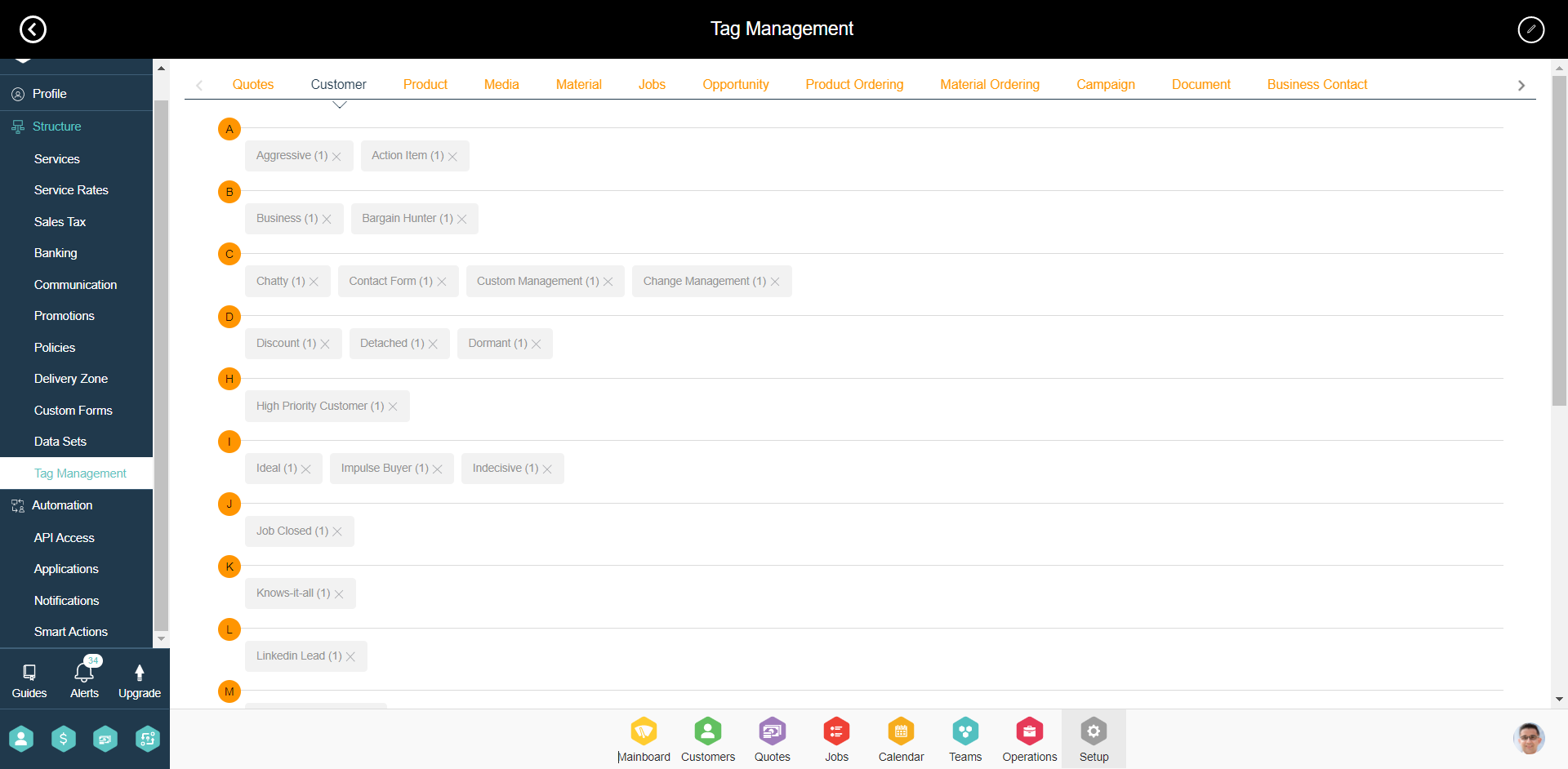
Navigation Reference: Setup → Tag Management → Customer
Manual Tags By User
Manual Tags are entered into the customer profile manually. Users can choose to enter an existing tag or enter a new tag. New tags are saved into the system for future reference. For example, you can label entities as:
- Customer with “Prospect”.
- Media file with “Blue Stage”.
- Hospital profile with “Trauma”.
- Product or product item (SKU) with “Kids”.
- Material or Materials Item (SKU) with “Bicycle Wrench”.
Make sure you add meaningful names for your tags since it will be easy while you search, create or edit information. Manual tags are called ‘Custom Tags’ in Jacktrade.
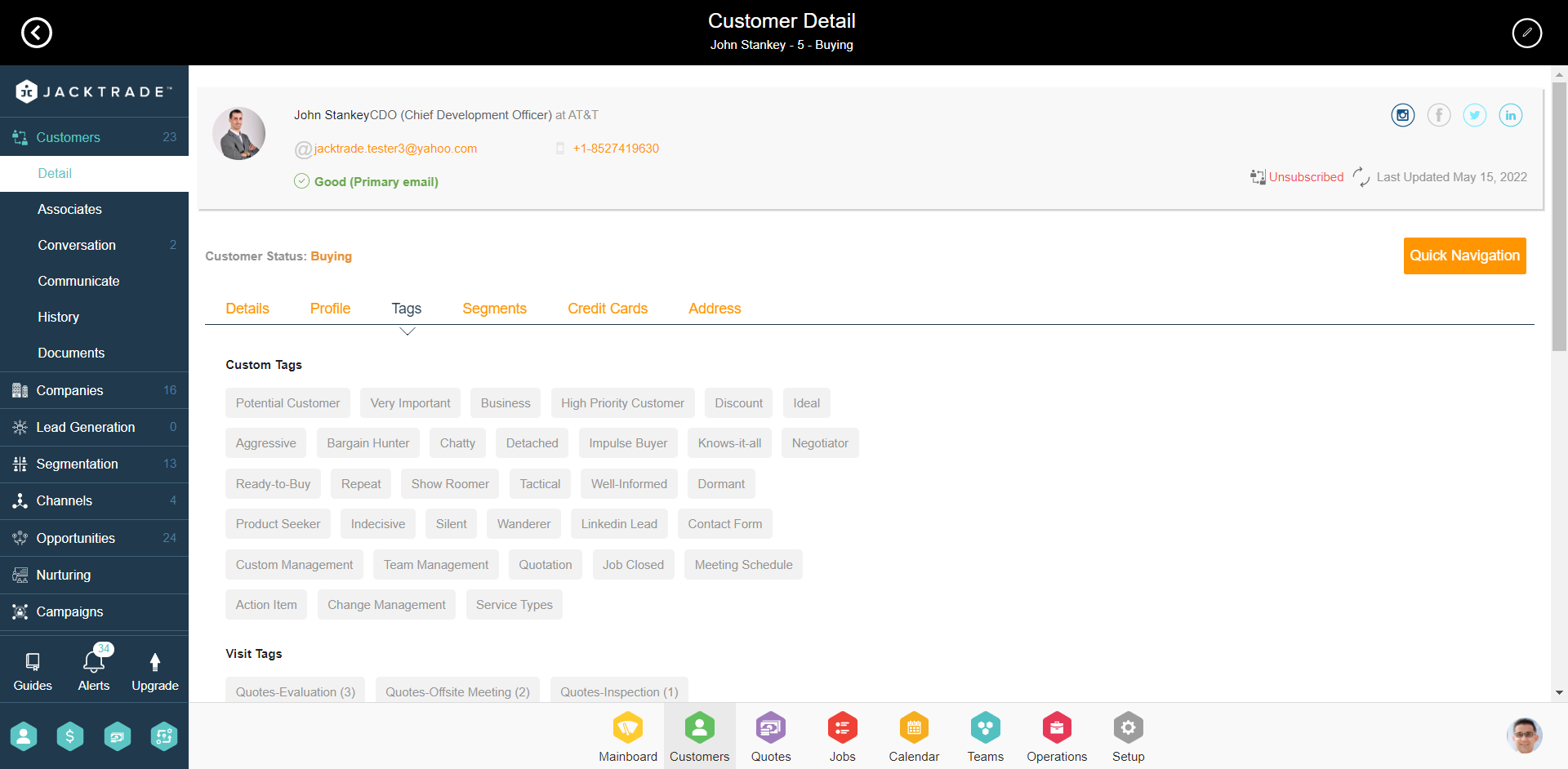
Reference: Customers → Customer Contact → Tags
Automatic System Tagging
Jacktrade automatically tags fundamental cases so you don’t even have to think about it. If a lead moves through your sales and marketing funnels, they’ll automatically be tagged with the appropriate label.
Automatic System Tags are the tags generated based on the user's action and are auto-generated by the system. You can use these tags as per your requirements. System Tags are further split as Manual Tagging and Automatic System Tagging.
Here are some examples of system tags
- In Media Repo, the user attaches a media file with a “product”. The Media is then labeled with a product name.
- In Resources, the user attaches an action item to an active Quote. The action item is then labeled with Quote ID.
- In Conversation, the user attaches the Support Case with Case ID. The Conversation post is then labeled with Support Case ID.
Note: When quotes get converted to Jobs, system tags get carried over to Job while converting records, so that the related records can be searched.
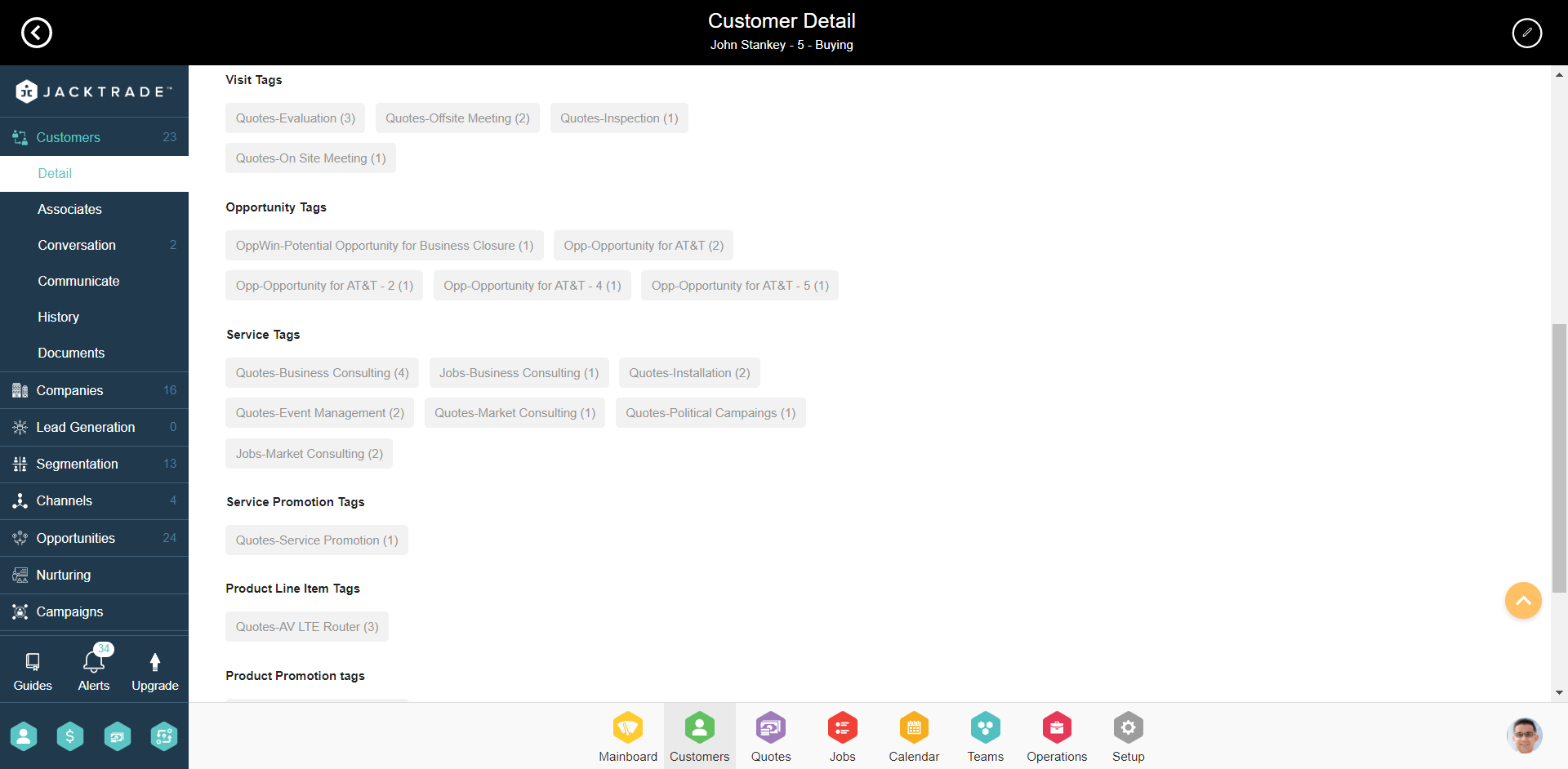
Reference: Customers → Customer Contact → Tags
Available To All
All tags are publicly available to all users in your ‘Team’. Tags are made public to reduce tag clutter and avoid duplicates.
Modules Using Tags In Jacktrade
Jacktrade uses tags throughout the application using adding ‘Custom Tags’ added by the user or the ‘System Tags’ added by the system automatically. The following diagram shows the classification of all these tags used:
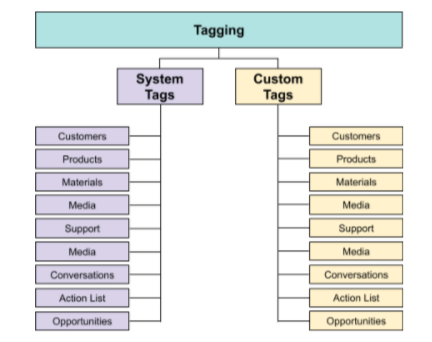
Consolidated Tags In Customer Profile
In the customer profile, all the associated manual and automatic tags are shown. This gives you a great view of everything that is going on with the customer. Here are some examples of how Jacktrade automatically tags that show in the customer profile
- When a product is purchased, the customer is labeled with that product name.
- When an opportunity is opened, the customer is tagged with that opportunity name.
- When media is uploaded, it’s automatically tagged with the business location of the user uploading the media.
Now you know everything you need to know about Tagging as a common function. By using the Custom and Manual tagging system appropriately, you can utilize this tagging system for your business to the best of its abilities.
Segmenting Your Contacts
Jacktrade supports segmenting your customers according to specific tags that may exist across business functions. For example, You can choose to segment customer records based on the product or service they are interested in, or they have bought, or are currently in the process of buying. Both manual and automated tags will help you group your customers as desired by your business processes.
Assign tags to organize your work with contacts. You will be able to filter and segment contacts according to certain criteria to find the contacts you need faster and individual work with each group. For example, you can add a tag based on customer preferences or change the status of working with a customer.
You can also create contact segments, filter contacts inside the segmentation list, and send personalized campaigns by selecting the desired audience segment by tag. Remember, personalization is extremely important for effective lead nurturing, and tagging your leads appropriately is the best way to go about it.
Tagging Data Management
For efficient operations of a system, it's important to know and understand how Jacktrade helps you manage your tagging data. Here are some general guidelines for tagging data:
- Pre-determine the key tags that you will use to keep your data organized.
- Keep data clean by using the right naming convention, and using correct spellings.
- Audit your data and make improvements to it as you move ahead with your business.
Jacktrade helps you manage these guidelines with tagging data management built into the platform.
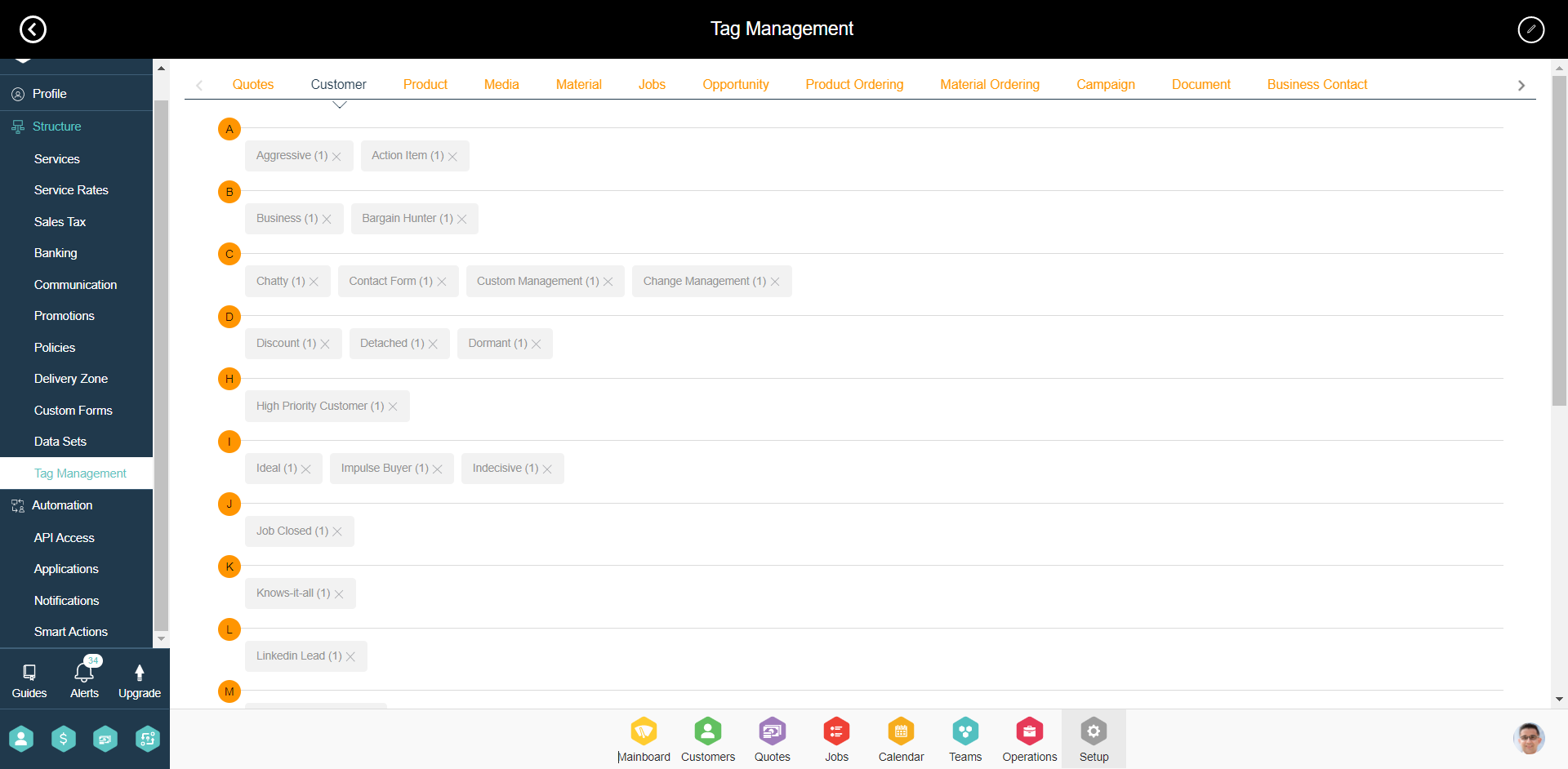
Don’t Do It On The Fly
While you may think of new tags to create at the moment, it’s best to plan your tags in advance so you can create them on your platform ahead of time. This will ensure nothing falls through the cracks and that when it comes time to tag a new lead, you can do so quickly and easily by grabbing a tag that already exists.
Tagging Machine
The customer list supports the ‘Tagging Machine’, and its primary purpose is to add tags in bulk to multiple entities as chosen by the user. Tagging machine is also available in many other functions within Jacktrade.
Applying Tags To Individual Records
Users can view tags, for example in the Customer List, Supplier List, or Media Repo, and then apply them to the entity. Many functions include viewing existing tags for a quick glimpse into what already exists, and also providing tag suggestions as you type them to add to any of the records.
Working With API
If you utilize Jacktrade’s contacts APIs, then you can add tags for specific events or triggers to build your customer segment and utilize this segmentation for various purposes including running email campaigns, managing leads, etc.
Tag Library In Business Settings
Jacktrade supports managing your tag data through your business instance. Tags can be managed globally and in bulk under Business Settings under Tag Management. Users can view tag libraries and browse tagged records used in different modules. As well as rename or delete tags to make modifications globally in your business. Note that deleting tags removes them entirely from the system.
Make sure you check in routinely to evaluate your tags. As your business grows, some tags may not be applicable and you would need to make room for new tags that are more accurate for your needs and customer behavior.
Tags once removed, are globally removed from all the data points that reference that tag. For example: if you removed the tag “old contact” and it was in 10 contacts - then all these contacts will no longer have “old contact” as part of their contact data.
